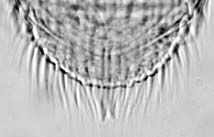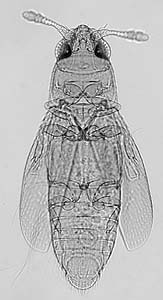Nanosella
W. Eugene Hall- Nanosella fungi
- Nanosella atrocephalus
- Nanosella matthewsi
- Nanosella panamensis
- Nanosella robustus
Introduction
Nanosella is widely distributed in nearctic and neotropical areas. It is commonly associated with polypore fungi, and in the United States is abundant in the eastern and southern regions. This genus is represented by the smallest beetles known, some records listing species of Nanosella as small as .25 or .26 mm. in total length.
An outline on the confusion surrounding the species of Nanosella is discussed in Barber (1924: 168). The nanoselline genus Mycophagous may be a synonym of Nanosella. A revision of both genera is currently being conducted.
Characteristics
Nanosella can be separated from other nanosellines (Dybas, 1990) by the 'arrowhead' shaped mesosternal process pointing posteriorly; 10-segmented antennae; elongate-oval form; mesocoxal suture directed anteriorly; prothorax widest at basal angles; pygidial spine of varying shape (acute, bifid).


Bifid pygidium of Nanosella
Dybas (1976) described the larva from a series of specimens collected at Cerro Punta, Chiriqui Province, Panama. As with many other genera of Nanosellinae, larvae and adults can be found inhabiting the same host fungus.
Geographic Distribution
Nanosella occurs in North, Central and South America. Unpublished records extend the distribution of Nanosella beyond these regions.
References
Barber, H.S. 1924. New Ptiliidae related to the smallest known beetle. Proc. Ent. Soc. Wash. 26(6): 167 - 178.
Dybas, H.S. 1990. Ptiliidae. in Soil Biology Guide, Daniel L. Dindail, editor. Wiley-Interscience, New York.
Dybas, H.S. 1976. The larval characters of featherwing and limulodid beetles and their family relationships in the Staphylinoidea (Coleoptera: Ptiliidae and Limulodidae). Fieldiana. Zoology. 70(3): 29 - 78.
Title Illustrations

| Scientific Name | Nanosella |
|---|---|
| Image Use |
 This media file is licensed under the Creative Commons Attribution-NonCommercial-ShareAlike License - Version 3.0. This media file is licensed under the Creative Commons Attribution-NonCommercial-ShareAlike License - Version 3.0.
|
| Copyright |
© 1997

|
About This Page
Page copyright © 1997
 Page: Tree of Life
Nanosella.
Authored by
W. Eugene Hall.
The TEXT of this page is licensed under the
Creative Commons Attribution-NonCommercial-ShareAlike License - Version 3.0. Note that images and other media
featured on this page are each governed by their own license, and they may or may not be available
for reuse. Click on an image or a media link to access the media data window, which provides the
relevant licensing information. For the general terms and conditions of ToL material reuse and
redistribution, please see the Tree of Life Copyright
Policies.
Page: Tree of Life
Nanosella.
Authored by
W. Eugene Hall.
The TEXT of this page is licensed under the
Creative Commons Attribution-NonCommercial-ShareAlike License - Version 3.0. Note that images and other media
featured on this page are each governed by their own license, and they may or may not be available
for reuse. Click on an image or a media link to access the media data window, which provides the
relevant licensing information. For the general terms and conditions of ToL material reuse and
redistribution, please see the Tree of Life Copyright
Policies.
Citing this page:
Hall, W. Eugene. 1997. Nanosella. Version 01 January 1997 (under construction). http://tolweb.org/Nanosella/9652/1997.01.01 in The Tree of Life Web Project, http://tolweb.org/








 Go to quick links
Go to quick search
Go to navigation for this section of the ToL site
Go to detailed links for the ToL site
Go to quick links
Go to quick search
Go to navigation for this section of the ToL site
Go to detailed links for the ToL site